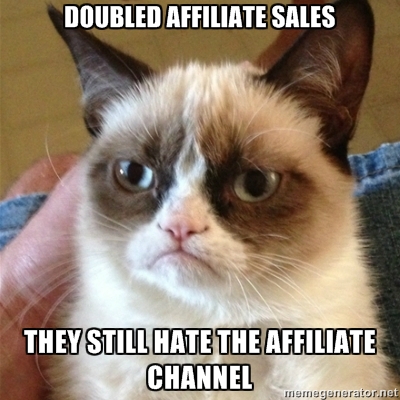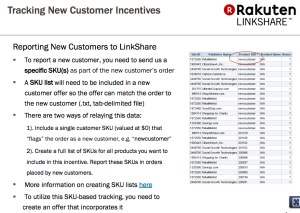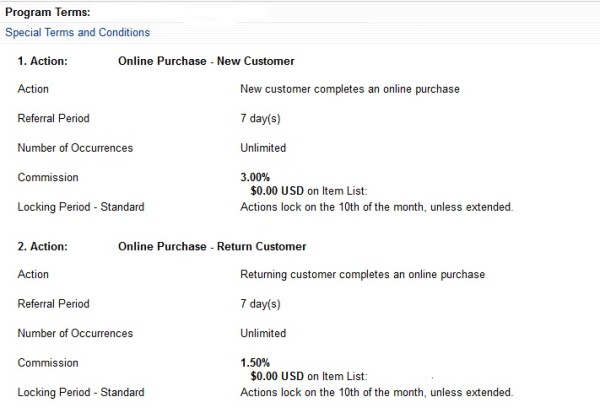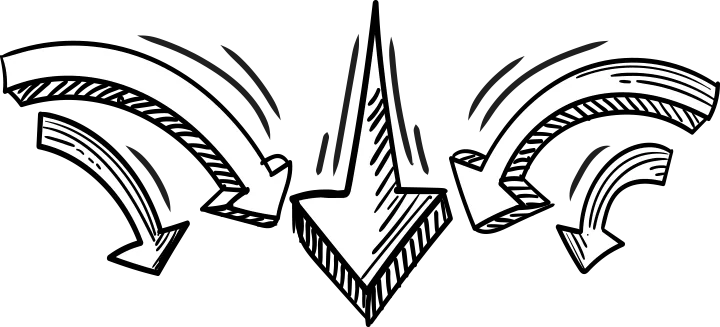 Have you increased affiliate sales dramatically and you are still getting the grumpy cat from the CEO? Than you have come to the right place. This is the 5th and final part in our series on incremental sales in affiliate marketing. Catch up on Part 1 and Part 2 andPart 3 and Part 4. We have discussed definitions, some possible ways to calculate incremental, who should be working on a project like this and things you should know before getting started.
Have you increased affiliate sales dramatically and you are still getting the grumpy cat from the CEO? Than you have come to the right place. This is the 5th and final part in our series on incremental sales in affiliate marketing. Catch up on Part 1 and Part 2 andPart 3 and Part 4. We have discussed definitions, some possible ways to calculate incremental, who should be working on a project like this and things you should know before getting started.
Today I wanted to do two things; 1) provide you with the technological ways that you can track, report and commission on incremental or new customers in many of the networks, 2) provide the networks an opportunity to give their input into this as well. I wanted to provide other industry luminaries an opportunity to submit their thoughts, but everyone must be busy. Please send me your comments, or comment below, should you like to get your thoughts out there.
So, let’s dive right in.
Technology, how to track, how to commission.
The obvious direction you’ll be going when you start this journey is to commission differently on the different qualities of customer. You may want to pay out more for incremental, new or high LTV customers, and lower for lower tiers of customers sent by affiliates. Maximizing revenue. You may simply want to know these numbers and not track through a network, or track and not commission differently. Knowledge is king and this data can help you paint a broader picture. Many of our clients track this and use it to decide where to spend paid placement dollars, who to give VIP commission rates to or simply who to spend the most time with. You don’t need to go the route of new commission structures, but if you need to, you can.
Almost all the networks offer you a way to differentiate a particular transaction as new or incremental and others as existing or non-incremental. I asked each one for input, and here is what we got.
ShareASale
SAS has some really interesting technology to assist with incremental sales and profitability. You can read about some of their features here. Their Leap from Transaction feature combats cart sniping: “If you note a pattern in your Affiliate Program that involves Affiliates earning commission on clicks very close to the time of the sale – you can setup a rule that skips past that click and looks backwards in the click-stream to see if there are any other Affiliates involved in the transaction. This can be extremely helpful in dealing specifically with Coupon and PPC Affiliates – to allow them to stay in the program while ensuring value.”
They also allow you to track and commission new vs existing, they call it Flexible Commissions: “Want to pay different commissions based on SKUs, categories, new customers, different stores, etc… There are endless possibilities – whatever you can think up can likely be accomplished with our system of rules and settings.”
The flexible commissions allows you to really commission different type of sales in just about any manner you choose. Be cognoscente of how this will effect your affiliate partnerships. Often times what looks good to the accountant will upset your base and can kill your entire program. You don’t want this exercise to do that. The key here is that you’ll need to be able to tag a sale when it happens. If you can’t tag a new customer, for instance, as a new customer when the sale happens and the pixel fires, you’ll need to go back to the drawing board.
Brian Littleton, CEO of ShareASale added: “By properly segmenting your Affiliates and utilizing customized commission rules – you can motivate them to generate the types of transactions that you are looking for. Instead of using “blanket” methodology such as removing all coupon Affiliates, use the data available and set commissions higher in instances of new-to-file customers, or in cases of greater than average order size … and lower in data-proven scenarios that you identify and want to correct.”
Linkshare
This network featured new customer acquisition campaigns at their symposium last month. Not only did they feature that it can be tracked, but acquiring new customers (most often the easiest way to determine incremental, but not without it’s own flaws) can be optimized and increased with solid tracking and outstanding strategy and tools.
Linkshare offers the ability to utilize their sku based reporting to track new vs. existing or incremental vs. non incremental. You can see it outlined in the following screenshot from a very good presentation on Publisher Incentives for New Customers.

The only downside could be that you may lose the sku of the product and thus lose some of the value of the product success reports. This solution really is great if you want to simply add an additional bonus for a new customer or incremental order. To get around this issue, you could send two sku’s, or two orders, one at a higher rate for new customers and one at a lower rate. Either way, it is relatively simple to pay out more on new or incremental.
Linkshare did commissioned a Forester Research paper that discusses the incremental value of affiliate programs and includes many statistics related to our discussion here. You can download the paper here.
Impact Radius
IR has technology to track new vs existing. It’s pretty simple and straight forward. You would be using an action tracker for each customer designation. You can “disposition” and action as either new or returning. I’m assuming you could disposition an action in any way you deem fit. You’ll just want to make sure it aligns with your corporate goals, is easy for the affiliate to understand and is something they can align themselves with.
We’ve done this and similar things with IR’s tracking and actions and it is easy to set up within IR.
Todd at IR made a great point that I want to stress here: “Equally important is reporting by partner on new vs returning (even if you aren’t paying differently) in order to determine each partners value.”
Commission Junction
CJ allows you to set up multiple actions, or conversion types, within their network. You can set up new customer actions, existing customer actions or group or tag them in any way you see fit. But it is important, as I’ve said above, to be sure that you can technical do this at the point of purchase, it’s easy to understand for affiliates, and doesn’t cut off your nose to spite your face. Setting up actions is relatively simple but there is a charge for each additional action in CJ.
I was able to speak with Sandrine Thompson, Strategic Insights Director at Commission Junction, briefly about CJ’s tracking options and incremental sales in general. Sandrine had some great insight:
“I examined incrementality a lot last summer when I presented a CJU session on the topic. Incrementality is a persistent question that faces marketers in all channels, but perhaps a bit more in affiliate due to our last-click payment model. Incrementality can be expressed in a few different ways, but sales from new customers are nearly universally accepted as incremental so it’s a great metric on which to focus.
A few years ago it seemed to be a challenge for advertisers to capture this metric, but sophistication in (and greater adoption of) site and channel analytics has improved the situation a great deal. Nowadays, I find more advertisers than not can assess new customers by channel (or they’re working on implementing the right analytics to do so).
At Commission Junction, our technology allows advertisers to report whether a sale was from a new or existing user and pay publishers differently, if desired. An advertiser who has the ability to provide new customer information at the transaction level can structure a program term something like the one below:

This functionality has allowed many of our advertisers to structure their affiliate program to greater meet their end goals. Because advertisers have a view into which publishers are driving new customers they can also be more strategic in optimizing and growing their publisher relationships. Tracking and reporting new customers in an affiliate program has been an important development toward advertisers being able to truly assess the value and incrementality of affiliate sales.
We have enough advertisers now reporting and tracking the new customer sales in the CJ network that we’ve been able to average the rate of new customers driven by affiliates. We consistently see that number average 25%, which is in line with third-party research on the topic which places the affiliate channel at about 2nd best for driving new users (behind Search).”
Great insight. You can read more from Sandrine at CJ’s blog here. https://blog.cj.com/01102013/incrementality-does-it-matter-cju-2012
Google Affiliate Network
GAN also has this capability. Beginning to see a pattern here? From our great account manager at GAN: “Google Affiliate Network is able to track and payout on both new and incremental customers. Advertisers can leverage our Category Level Commissions feature to pay different amounts for orders placed by new and existing customers. Advertisers need to identify new versus existing customers at the time the order takes place and provide the appropriate data to Google Affiliate Network.”
AvantLink
We have several of our clients on this network. They have some amazing technology, check out their Advanced Link Encoder if you have content affiliates, and continue to make waves in our industry. They are able to track demographics of orders, such as new customer, existing customer, incremental sale, non incremental sale, through the use of an additional parameter in the pixel when it is fired. For this exercise, the additional variable could be “new_customer”.
From AvantLink:
“It should be entered into the tracking that is described in the documentation found here: https://www.avantlink.com/documentation/integration/avantmetrics-tracking-integration/, so the tracking code would look like this:
<script type=”text/javascript”>
var _AvantMetrics = _AvantMetrics || [];
_AvantMetrics.push([‘order’,{ order_id:'[ORDER_ID]’, amount:'[ORDER_AMOUNT]’, state:'[BILLING_STATE]’, country:'[BILLING_COUNTRY]’, new_customer:’Y’ }]);
_AvantMetrics.push([‘item’,{ order_id:'[ORDER_ID]’, parent_sku:'[ITEM_PARENT_SKU]’, variant_sku:'[ITEM_VARIANT_SKU]’, price:'[ITEM_PRICE]’, qty:'[ITEM_QUANTITY]’ }]);
</script>
The value for new_customer should be ‘Y’ or ‘N’.
AvantLink can structure commission payouts to be awarded to affiliates only when a referral is a new (or ‘Y’) customer, should the merchant wish to set up their commission payouts that way.”
Chad Waite was gracious enough to add another $.02 to the discussions: “Affiliate marketing isn’t the simple “last click wins” model it was a decade ago- a lot has changed. Program managers are now placing greater emphasis on getting and reacting to in-depth insight on the different values of returning vs. new customers, how other marketing channels overlap with the affiliate channel, and attribution logic for multiple affiliate referrals. AvantLink’s ability to record new/returning customers as well as their AvantMetrics attribution platform provides solutions to these issues and delivers program managers that in-depth insight to their programs they need to show that sales made through their affiliates are indeed incremental. “
Thank you to all the networks for providing great information, insite and assistance in putting together this post. Many echoed the same themes:
- We have better data now then we did before
- Advertisers are able to look at traffic and customers coming from affiliates in general and specific partners and are able to determine better value metrics that help them become more profitable
- Analysis like this is coming from more and more advertisers
- Our industry needs to embrace this
We’ve seen this coming down the road for a long time and I’m excited to see the networks offering ways to track affiliate programs and their success better. In the end it will only make this channel stronger and will help affiliate managers get a more stable seat at the digital marketing table.
Affiliates, don’t be scared of this process. For those of you who are generating truly unique traffic, you’ll find there is more budget to work with you and you’ll see your revenue increase. For those of you who aren’t driving the strongest traffic, you’ll now know where you are weak and where you are strong. It will give you an opportunity to strengthen your company and your bottom line.
This is a big topic and it takes time to get your head around it and develop a plan. If you are looking for help getting to a better platform of profitability, whether advertiser or publisher, don’t hesitate to call me at 800-208-6215, or email or even use our Live Chat option. We’d love to help you become more profitable.
Thank you again to all of you who provided great information.
And hey, let’s hear your comments below and don’t forget to share this with others. If you disagree, I’d love to hear it!

